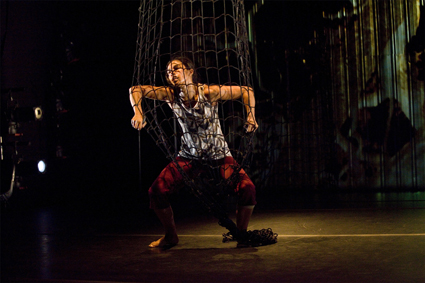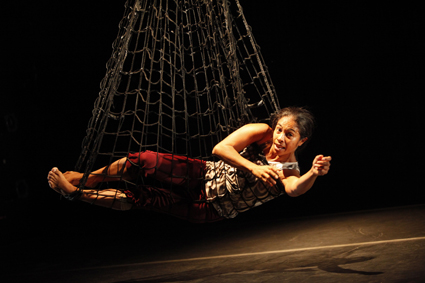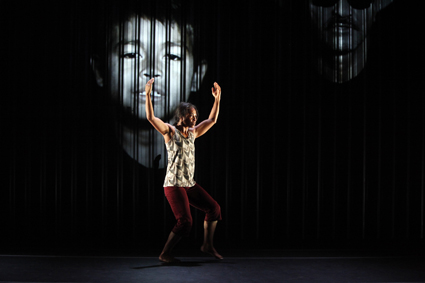 |
Dalisa Pigram, Gudirr Gudirr, Marrugeku photo Ponch Hawkes |
For a solo, this is one BIG performance. Accompanied by video projected onto a corrugated iron wall upstage and a long fishing net suspended from the ceiling, Pigram otherwise fills the space for 60 minutes with her intense presence. Gudirr Gudirr (the words call a warning) is a powerful commentary on life in multi-racial Australia told through the experience of this dancer who has a Malay father and Aboriginal mother and lives and works in the country’s north-west. From time to time, the video reminds us of the locale with at once calming and unsettling images of the place and its people.
In a projection of the text, we’re reminded once more of Australia’s racist history. In 1928 an official informs A. O. Neville, Chief Protector of Aboriginals in Western Australia (1875-1954) that quarter-caste Indigenous people (“quadroons”) will be “useful in replacing Aboriginals” as labour for the industries of the north. For this reason, Broome is exempted from the odious White Australia Policy. Pigram appears in fighting stance then moves on to describe in a mix of Yawuru language, Aboriginal English and vivid gesture a joyous experience of fishing with her family that turns dangerous as they overfill their net and are threatened by a crocodile. Harvesting only what’s needed is just one of the survival lessons learned.
From exuberant recreation, Pigram shifts deftly through a parodic airline steward sequence to a series of multi-faceted choreographies variously expressing frustration, resistance, despair, forbearance and celebration. Contained within a strong and compact body her dance mixes Malaysian martial manoeuvres (Silat)—anchored by a low centre of gravity with extended leg and expressive arms—with stances we have come to know from Indigenous dance—solidly grounded feet, torso and hips suddenly and sharply changing plane and aspect, references to animal movement. Moving easily between these forms—a martial stance is enlivened with a quick, animal flick of the wrist—Pigram displays a light-footed grace and a sharp-eyed focus that holds us keenly on her wavelength.
 |
Dalisa Pigram, Gudirr Gudirr, Marrugeku photo Ponch Hawkes |
In the program notes, Pigram describes the generation of these shifting gestures and personas as resulting in part from the ‘task-based process’ she embarked on with director and co-choreographer Koen Augustijnen—a regular collaborator on Marrugeku projects who has also worked with Alain Platel’s Les ballets c de la b—and which together they named “The Tide is Turning.” Says Pigram: “I explore the point in my memory where it felt like my community was changing. I interpret this time through a range of ‘movement channels’ inspired by different characters. Following the task to ‘change the channels,’ I am introducing myself, and others from my community, from the inside out. The audience may see what’s inside of me. They may see the issues that I have that exist as inspirations and concerns through the movement of these characters until they are left with just a person before them, with a story.”
 |
Dalisa Pigram, Gudirr Gudirr, Marrugeku photo Ponch Hawkes |
The work concludes with projected portraits of relatives and friends who form an important part of Pigram’s community, women and children, elders including a white haired man we’ve seen earlier dancing slowly on the screen, and finally the familiar bearded countenance of cultural advisor on this and other Marrugeku projects, Patrick Dodson. Stephen Pigram’s song provides soothing accompaniment as Dalisa Pigram repeats a sequence of calming hand gestures seen earlier on screen.
Gudirr Gudirr is a truly timely work that should be seen widely. Showing all the signs of careful collaboration from a gifted team it conveys complex experience in the shape of Dalisa Pigram who shows us in the sharply shifting facets of her performance the rich and troubled life of her community and of this country.
Dance Massive, Arts House: Gudirr Gudirr, concept, performer and co-choreographer Dalisa Pigram, director and co-choreographer Koen Augustijnen, set design and video artist, Vernon Ah Kee, video production Sam James, composer & sound designer Sam Serruys, singer and songwriter Stephen Pigram, lighting design Matthew Marshall, concept and cultural advisor Patrick Dodson, dramaturg & creative producer Rachael Swain, executive producer John Baylis. Produced by Stalker Theatre and co-commissioned by the City of Melbourne through Arts House, Theatre Im Pfalzbau, Ludwigshafen (Germany) and Les Théâtres de la Ville de Luxembourg; Marrugeku, Arts House, Meat Market, Melbourne, March 12-16; http://dancemassive.com.au/
RealTime issue #114 April-May 2013 pg. 27
© Virginia Baxter; for permission to reproduce apply to [email protected]








 back
back